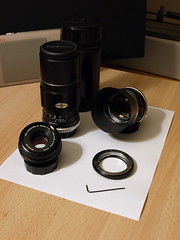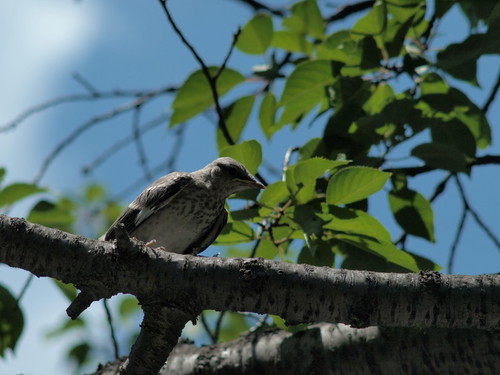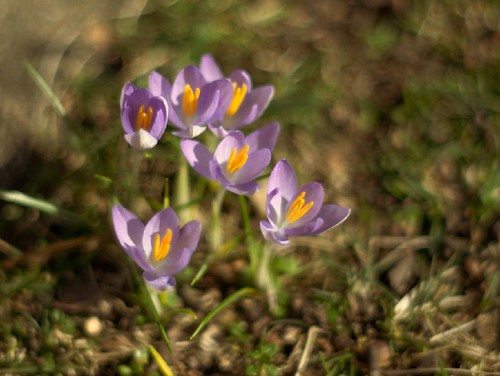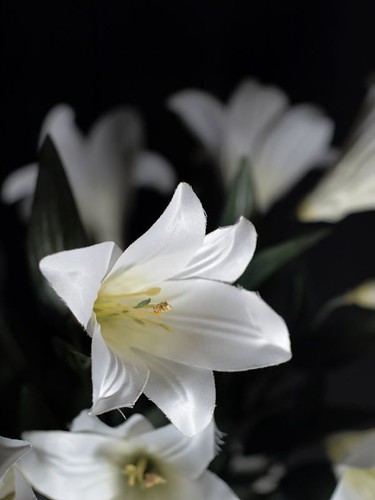Minolta Lenses on Four Thirds Cameras
I started getting hooked on Minolta lenses after purchasing a Rokkor 45mm f/2.0 lens for use with my E-510. I wanted a lightweight and compact lens, similar to a "pancake" lens (I had almost bought a K10D and one of Pentax's nice pancake primes). I have always admired the Zuiko lenses from the film era, but never owned any until after I bought my Olympus E-510, but after getting a 50mm f/1.4 and 50mm f/1.8 I wanted something still smaller and lighter. The OM to 4/3 adapter I bought was a sizeable hunk of metal and the combination of the 50mm f/1.8 or even the tiny 35mm f/2.8 did not suit my idea of a pancake lens. Although I had admired Hexanon lenses in the 1980s and thought about converting the very sharp 40mm f/1.8, I was put off by the various hand made shims required and at the time, the lenses became popular on ebay and the prices shot up. I decided to rummage around in ebay's listings for other brands and came up with the Rokkor 45mm. At the time, RJ announced he was coming out with a Minolta to 4/3 adapter, so I bought a 45mm, and as soon as they were available, an adapter.
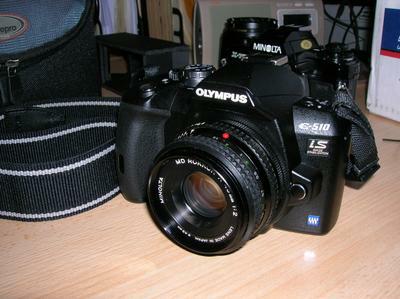
Since I had the adapter and Minolta film era lenses were selling for much less than other brands (probably due to lack of adapters to 4/3 or EOS) and my new interest in Minolta led me to buy an X-700 (a camera I always admired), I picked up a 50mm f/1.4 (to see how well it performed against the OM) and a 50mm f/1.7 to use on the camera. After reading about the excellent bokeh (some argue the best of any normal lens from the film era) of the Rokkor 58mm f/1.2, I decided to try the 58mm f/1.4 to see what the bokeh was like without breaking the bank. Frustrated with the slow speed of the ZD 150mm kit zoom, I picked up a very inexpensive Rokkor 200mm f/4.5 in near mint condition.
I am not using my Rokkor lenses as much as I did. I bought a Panasonic Leica 14-50mm lens, which to my eye offers a lot of the characteristics of legacy optics with autofocus (at 50mm). I am sure if I had a larger viewfinder with focusing aids (split prism, microprism ring) I would have had much better results with manual focus on a modern digital camera. I am still keeping my manual lenses for special uses. The 50mm f/1.8 range lenses are excellent for portraits, they are fairly sharp, good low light lenses, whether the Zuiko 50 or the Rokkor 50. I just bought a Zeiss 50mm f/1.7 Planar T* for use on my E-510, which is the sharpest and clearest lens I've ever used (although there is some debate, it is probably sharper than the f/1.4 version, but I decided to save money and give my eyes a break with the greater depth of field the slower lens provides).
Minolta to 4/3 Adapter Issues
Because of the short flange distance, the Minolta adapter is too thin to implement the Minolta mounting lock. The adapter comes with a set screw, which uses friction to hold the lens in place. This makes it necessary to loosen the set screw before removing the lens, change the lens, tighten the screw again, a tedious and time consuming procedure when changing lenses. The alternative is to purchase an adapter for each lens. The Minolta adapters are more expensive than others, so the savings in lens cost may be eaten up in adapters. I use one adapter, since I only use the Minolta lenses for special images or purposes. I use the Minolta lenses for their bokeh or image qualities, not as general walk around lenses (I use the ZD kit lenses in that case).
The Rokkor 45mm f/2.0 is so light and the focus turns so easily I have never had the lens come off in my hand while focusing, with the set screw not tightened all the way down. I can remove it from the adapter easily and mount another lens without keeping the screw tight. I have had both the 58mm f/1.4 and the 200mm f/4.5 come off in my hand while focusing without the set screw being tightened down. The 200mm is a chunky lens and after a few pictures, despite the smooth turning focus ring, it will work loose from the adapter if the set screw is not cinched down as tightly as possible. My 58mm focusing ring is a bit stiff. I have the 50mm f/1.4 and f/1.8 and will tighten the set screw on those. The f/1.8 is a little less risky leaving the screw neutral.
I started out with OM lenses and an OM to 4/3 adapter. The OM lens mounting lock is part of the lens mount, not the camera, so the adapter is not required to perform the locking function. You should consider this when deciding whether to go with OM or Minolta legacy lenses. With a single OM adapter, you can leave the adapter mounted to the camera body and change the lenses normally, as if they were on an OM-system camera.
Examples
So here are examples from my Rokkor lenses. All from the E-510. Manual focusing is a challenge, but these are some of the better examples.
Rokkor 200mm f/4.5 Partially backlit, but turned out very sharp. On 4/3, the field of view is similar to 400mm on 35mm and is the longest telephoto I own, besting the ZD 40-150mm by 100mm. There is a slight purple "noise" on the upper edge of the branch, not sure if it is CA or not.
About the lens. The lens is in almost brand new condition, in the original case with Minolta Skylight 1A filter, original Minolta metal front lens cap and plastic Minolta rear cap.
Rokkor 58mm f/1.4 @ f/1.8 This was nearly wide open.
Rokkor 58mm f/1.4 @ f/8
Rokkor 45mm f/2.0 @ f/2.8 Cloth lilies illuminated by incandescent flood lamps. Focusing was by LiveView at 10x magnification with the focus area over the stamen, which satisfies my long time desire to experience using a view camera.
About the lens. Very nice, clean lens. Not exactly the solid construction of the older Rokkor 58, but it is extremely light weight and compact mounted to my E-510. It gives the camera an old style SLR feel. A test I made comparing the Rokkor 45mm against the ZD 14-42mm kit zoom showed the Rokkor to be superior in edge sharpness.
Image Stabilization
One advantage of the in body image stabilization on Olympus cameras, is all manual focus lenses are image stabilized when mounted to an E-510/E-520/E-3/E-30 camera body, given you have current firmware and set the focal length manually. This means my Rokkor 200mm gives about the same field of view as a 400mm lens on a 35mm camera and is image stabilized.
Items of Interest
Electrified conversion of the Minolta 58mm f/1.2 Rokkor
Olympus E500 with Minolta Lens Adapter
Minolta to Olympus 4/3rds Adapter - This appears to be the same as ordered from RJ camera.
MD to 4/3 Adapter - A reply notes the aperture pin clears the 510 for the 50mm f/1.7, which confirms my experience. As always, there are variations in manufacturing of a lens model made over many years, so be careful the first time you mount a new lens.
